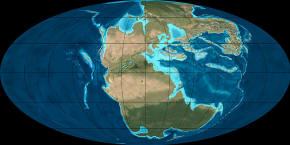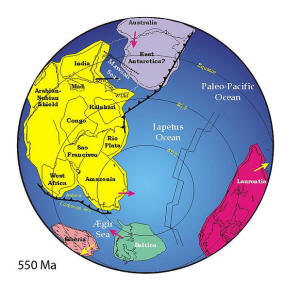|
The continent of Gondwana was named
by Austrian scientist,
Eduard Suess, after
the
Gondwana region of
central northern India (from
Sanskrit gondavana
"forest of
Gond"), from which
the Gondwana sedimentary sequences (Permian-Triassic) are also described.
The adjective
"Gondwanan" is in common
use in
biogeography when
referring to patterns of distribution of living organisms, typically when
the organisms are restricted to two or more of the now-discontinuous regions
that were once part of Gondwana, including the Antarctic flora. For
example, the
Proteaceae, a family
of plants that is known only from southern South America, South Africa, and
Australia are
considered to have a "Gondwanan distribution". This pattern is often
considered to indicate an archaic, or
relict, lineage.
Formation
The assembly of Gondwana was a
protracted process. Several
orogenies led to its
final amalgamation 550–500 million years ago at the end of the Ediacaran, and into
the Cambrian.
These include the Brasiliano Orogeny, the
East African Orogeny,
the
Malagasy Orogeny, and
the Kuunga Orogeny. The
final stages of Gondwana assembly overlapped with the opening of the
Iapetus Ocean between
Laurentia and western
Gondwana. During this interval the Cambrian Explosion
occurred.
Gondwana was formed by these
earlier continents and
microcontinents, and
others, colliding in these orogenies:
 |
Azania: much of
central Madagascar, the Horn of Africa
and parts of Yemen and Arabia. (Named by
Collins and Pisarevsky (2005): "Azania" was a Greek name for the East
African coast.)
|
 |
The Congo–Tanzania–Bangweulu
Block of central Africa.
|
 |
Neoproterozoic India: India,
the Antongil Block in
far eastern Madagascar, the Seychelles, and
the Napier and Rayner Complexes in East Antarctica.
|
 |
The Australia/Mawson
continent: Australia west of Adelaide and a large extension into East Antarctica.
|
 |
Other blocks which helped to
form Argentina and
around, including a piece transferred from Laurentia when
the west edge of Gondwana scraped against southeast Laurentia in the
Ordovician.
This is the Famatinian block, and it formerly continued the line of the
Appalachians
southwards.
|
 |
|
One of the major sites of Gondwana amalgamation was the
East African Orogen, where these two major orogenies are superimposed on
each other:
 |
The East African Orogeny (as later
defined) at ~650–630 Ma affected a large part of Arabia, north-eastern
Africa, East Africa and Madagascar. Collins
and Windley (2002) propose that in this orogeny Azania collided with the
Congo–Tanzania–Bangweulu
Block.
|
 |
The later Malagasy orogeny at ~550–515 Ma affected
Madagascar, eastern East Africa and southern India. In it Neoproterozoic
India collided with the already combined Azania and Congo–Tanzania–Bangweulu
Block.
|
At the same time, in the Kuunga Orogeny Neoproterozoic
India collided with the Australia/Mawson continent.
Pangaea
Other large continental masses,
including the cores of North America (Canadian
Shield or Laurentia), Europe (Baltica),
and
Siberia were added
over time to form the supercontinent
Pangaea by
Permian time. When
Pangaea broke up (mostly during the Jurassic), two large
masses, Gondwana and
Laurasia, were
formed.
When Pangaea broke up, the
re-formed Gondwana continent was not precisely the same as before Pangaea
formed; for example, most of Florida and southern
Georgia and Alabama are underlain
by rocks that were originally part of Gondwana but that were left attached
to North America when Pangaea broke apart.
During the late Paleozoic, Gondwana
extended from a point at or near the south pole to near the equator. Across
much of Gondwana, the climate was mild. During the Mesozoic, the world
was on average considerably warmer than today. Gondwana was then host to a
huge variety of flora and fauna for many millions of years. But there is
strong evidence of glaciation during Carboniferous to
Permian time,
especially in South Africa.
Breakup
 |
|
A global paleogeographic
reconstruction of the Earth during the Late Triassic, approximately
220 million years ago, showing Gondwana breaking away from Laurasia
in the north (Picture
Source)
|
Gondwana began to break up in the
mid-Jurassic (about
167 million years ago), when East Gondwana, comprising Antarctica,
Madagascar, India and Australia, began to separate from Africa. South
America began to drift slowly westward from Africa as the South Atlantic
Ocean opened, beginning about 130 million years ago during the Early
Cretaceous, and
resulting in open marine conditions by 110 million years ago. East Gondwana
then began to separate about 120 million years ago when India began to move
northward.
The Madagascar block, and a narrow
remnant microcontinent presently occupied by the Seychelles Islands,
were broken off India; elements of this breakup nearly coincide with the
Cretaceous-Tertiary extinction event.
The India–Madagascar–Seychelles separations appear to coincide with the
eruption of the Deccan basalts, whose
eruption site may survive as the
Réunion hotspot.
Australia began to separate from
Antarctica perhaps 80 million years ago (during the Late Cretaceous), but sea-floor
spreading between them became most active about 40 million years ago during
the Eocene epoch of the
Tertiary Period.
New Zealand probably
separated from Antarctica between 130 and 85 million years ago.
As the
age of mammals got
underway, the continent of Australia-New Guinea
began gradually to separate and move north (55 million years ago), rotating
about its axis to begin with, and thus retaining some connection with the
remainder of Gondwana for about 10 million years.
About 45 million years ago, the
Indian Plate collided
with Asia, buckling the crust and forming the
Himalayas. At about
the same time, the southernmost part of Australia (modern
Tasmania) finally
separated from
Antarctica, letting
ocean currents flow between the two continents for the first time. Cooler
and drier climates developed on both continents because ocean currents
enveloping Antarctica were no longer directed into the subtropics, where
they would have flowed around northern Australia.
The separation of
South America from
West Antarctica some
time during the
Oligocene, perhaps 30
million years ago also caused climate changes. Immediately before this,
South America and East Antarctica were not connected directly, but the many
microplates of the
Antarctic Peninsula
remained near southern South America acting as "stepping
stones" allowing continued biological
interchange and stopped oceanic current circulation. But when
Drake Passage opened,
there was now no barrier to force the cold waters of the
Southern Ocean north,
to be exchanged with warmer tropical water. Instead, a cold circumpolar
current developed and Antarctica became what it is today: a frigid continent
that locks up much of the world's fresh water as ice. Sea temperatures
dropped by almost 10°C, and the global climate became much colder.
By about 15 million years ago, the
collision between New Guinea (on the leading edge of the Australian Plate)
and the southwestern part of the Pacific Plate pushed up the New Guinea
highlands, causing a
rain shadow effect
which drastically changed weather patterns in Australia, drying it out.
Later, South America was connected
to North America via the
Isthmus of Panama,
cutting off a circulation of warm water and thereby creating the Arctic,
as well as allowing a
faunal interchange
between the two continents.
The Red Sea and
East African Rift are
modern examples of the continuing dismemberment of Gondwana.

Return to the
Old Earth Ministries Online Earth
History Curriculum homepage.

Source:
Gondwana
|

